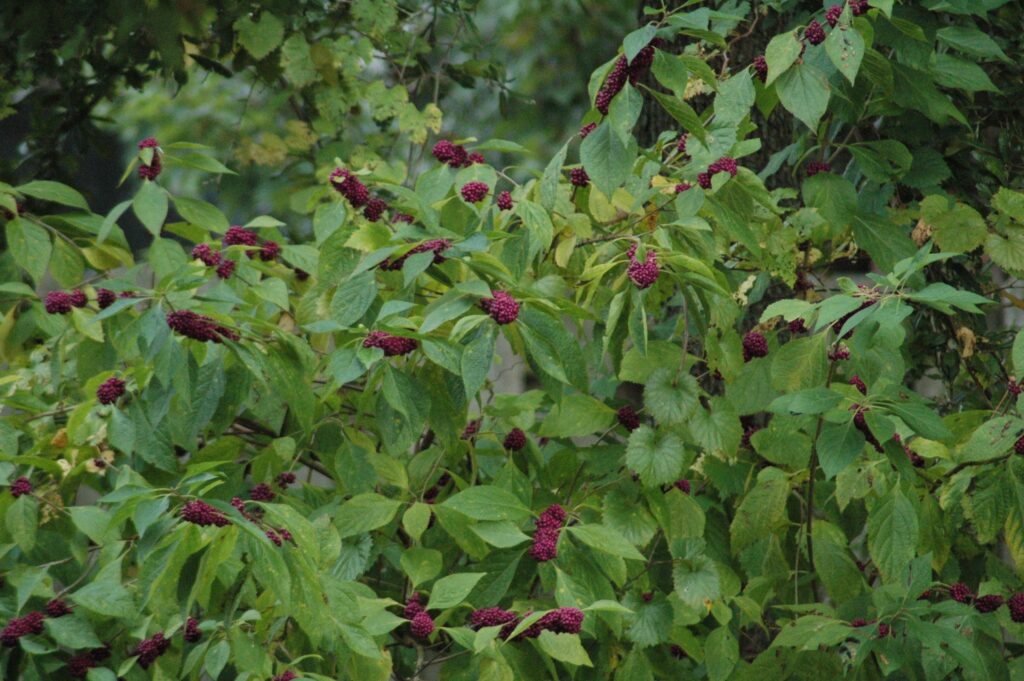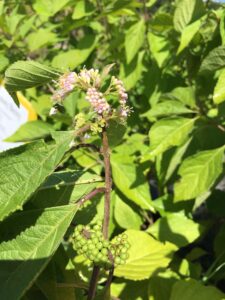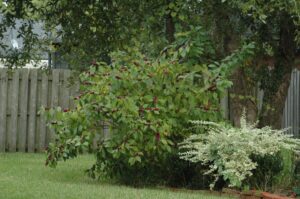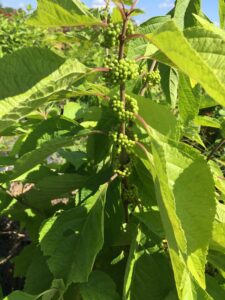Florida Native Beauty Berry
for Northeast Florida,
Jacksonville | St. Augustine area Landscapes
( Callicarpa americana)

Origins of Callicarpa americana / American Beauty Berry :
– Beauty berry Callicarpa americana is native to the pinelands and hammocks throughout Florida and is a perennial woody shrub with beautiful flowers and brightly colored fruits ( berry looking drupes) that decorate the plants is summer and fall.
Beauty berries are an excellent source of pollen for native butterflies, bees and other pollinators and the berries are utilized by birds.
Beauty berry makes an easy care plant selection with little to no disease of pest problems and no trimming required if you give it plenty of room at the back of the border.
Preferred Exposure for American Beauty Berry Callicarpa americana:
– beauty Berry can be planted into full sun location but will look its best in a part sun part shade situation here in the Northeast Florida, Jacksonville | St. Augustine area landscape.
– If planted into a full shade location that gets only indirect light all day, plants may not bloom as well and foliage can become a bit thinner or not as lush and full. Dappled sun throughout the day under tall trees works well or areas that will receive some sun and some shade during the day are more ideal.
Foliage of the Beauty Berry Plant:
– Deciduous plant selection, beauty berry will drop its leaves for the winter season. Large bright green foliage on upright spreading branches give way to fruits during late summer that pull those branches downward giving them a beautiful rounded weeping habit.
- Leaves crushed and rubbed against the skin are supposed to make a natural mosquito repellant.
Soil Preference and Salt tolerance of the American Beauty Berry:
– Beauty berry will grow happily in moist or occaisionally wet, sandy and dry well drained soils. Beuty berry is really quite drought tolerant when established into the landscape. May benefit from supplimental irrigation when planted into drier soil locations during periods of prolonged drought.
–not really particular about soil components and grow equally as well in sandy soils as they do in clay.
– Beauty Berry shrubs have a low salt tolerance and should be avoided for coastal plantings.
Size Variance of Beauty Berry :
– Can reach sizes of 4-8+ feet High | 4-6 feet Wide but respond well to pruning and can be maintained lower with annual pruning.
Space plants at a minimum of 2-3 ft from the center of one plant to the center of another for foundation plantings.

Growth Habit of Beauty Berry:
– Has an somewhat sprawling rounded or spreading shape that will as it ages weep over with arching stems nearly touching the ground.
Growth Rate of the Beauty Berry:
– Fast growing plants can easily add a foot or more to their height in ideal conditions in one growing season. If you are planning on maintaining these plants at a lower height, remember to trim 4-6 inches beneath where you would like to see the plants height and shape as they will re-flush new growth and blooms almost immediately after trimming. Expect to get 4-8″ of growth in a growing season until mature.
Blooms of the Beauty Berry plant:
– Beauty Berry blooms may be lavender, pink or even white and are born close to the stem at the leaf axis in tight clusters. They attract butterflies, hummingbirds and other pollinators to the garden. Late spring and early summer blooms are followed by a brilliant display of fruit clusters that are a beautiful bright purple and an excellent source of food for birds. Fruits are edible but a bit tasteless and are often made into jelly using a bit of lemon and sugar to add some flavor.
Water Requirements of the Florida Native Beauty Berry Plant :
– Beauty berry have fairly low to moderate water needs once they are established into the landscape. Water weekly during extended dry periods or drought once the plants have grown into the landscape.
Remember to check their water needs daily after planting to get them rooted and established into the landscape quickly.
– Watering your newly planted smaller shrubs and flowers

Butterfly or Bird Attracting:
– Attracts butterflies hummingbirds and other pollinators to the garden.
- Birds utilize the fruits ( drupes) especially as other local berry sources decline in late summer and fall.
Best Uses For Beauty Berry Plants in the Northeast Florida, Jacksonville | St. Augustine area Landscape :
– Beauty Berry is a larger growing plant that is well suited to the back layer of home foundation plantings or can be used as a small ornamental accent plant or patio tree if left untrimmed.
– Beauty berry are perfect for massed plantings in large groupings under taller palms and trees or as under plantings for the edges of natural forested areas or larger native Oaks and Maples.
Care of S & J Nursery’s North Florida | Jacksonville | St. Augustine
Shrubs:

– Beauty Berry should be pruned once or twice a year to shape when they begin to be untidy.
– Beauty Berry shrubs can be planted in the North Florida | Jacksonville | St. Augustine area at any time during the year. In normal and well draining soils dig the hole as deep as the root ball and two to three times as wide. Plant the top of the root ball level or slightly higher than the surrounding soils. Avoid planting in poorly drained soils.
– Check the plants water needs every day during the establishment period. For most 3 gallon size shrubs in the North Florida landscape in average soil, that is neither heavy clay that holds water or really sandy that will take 2-3 weeks of daily watering to ensure that your newly planted shrub will begin to put out new roots and grow into its new home happily. After the first few weeks begin tapering back your watering to every other day then every third day and so on until your newly planted items are flourishing without your assistance.
– Beauty Berry may need supplemental irrigation during times of excessive heat or drought, especially when planted into locations with more sunshine.
– IMPORTANT: If planting shrubs in heavy clay soils that hold allot of water after a rain or irrigating, remember to check the soil for moisture by sticking your fingers into the soil near the root ball of the newly planted shrub down to 2-3 inches. If it remains wet from the previous watering wait for the top 2-3 inches to dry out before watering again.
– IMPORTANT: When planting shrubs into poor sandy soils be sure to amend the planting hole by mixing compost or cow manure etc. with the native soil that will go back in the hole around the new plants root ball when installing your shrub material, this will not only give your new shrubs good soil to grow its new roots into but help it hold water.
– When planting shrubs from containers be sure to loosen the roots as much as possible pulling loose roots away from the root ball before installing your new plants, if the roots are to tight to easily loosen with your hands use a knife to cut a few slits into the root ball being careful to go all
the way from the top to the bottom and making the cut at least an inch deep. This will ensure that your plant will immediately begin to form new roots into its new surrounding soil.
Planting your new smaller shrubs and flowering plants
– Mulch newly planted shrubs whenever possible. Shrubs will benefit from a 3-4 inch layer of arborists wood chips, Pine bark or Pine Straw.
– Fertilize each spring with a shovelful of good garden compost or a mixture of Milorganite and a good quality slow release poly coated plant food like Stay Green or Osmocote. Be sure when fertilizing to sprinkle the fertilizer around the mulch circle underneath the foliage of the shrubs.

